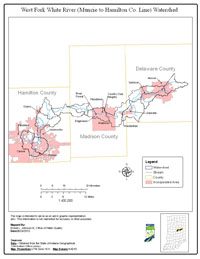Location
The West Fork White River (Muncie to Hamilton-Marion County Line) Watershed is located in central Indiana, draining approximately 186 square miles in Hamilton County. The Major stream included in the Total Maximum Daily Load (TMDL) report is the West Fork of the White River.
History
A comprehensive survey of the West Fork White River (Muncie to Hamilton-Marion County Line) Watershed was conducted by Indiana Department of Environmental Management (IDEM) in 2004 and 2007. The primary cause of impairment is Escherichia coli bacteria (E. coli). Pollution sources in the watershed include nonpoint sources from agriculture and pastures, land application of manure and urban and rural run-off, as well as point sources from straight pipe discharges, home sewage treatment system disposal and combined sewer overflow outlets.
Pollutants Addressed
TMDLs for the West Fork White River (Muncie to Hamilton-Marion County Line) Watershed are established for E. coli and will address 12 impairments. Some of the recommended solutions to address the impairments include storm water controls, point source controls, manure management and habitat improvements.
Timeline
A kickoff TMDL meeting was held on October 1, 2002 at the Anderson Public Library, 111 E. 12th St., Anderson, Indiana starting at 6:00 p.m.
A draft TMDL meeting was held on December 4, 2003 at the Anderson Public Library, 111 E. 12th St., Anderson, Indiana starting at 6:00p.m.
The 30-day public comment period for the draft West Fork White River-Muncie to Hamilton-Marion County Line Watershed TMDL began on December 2, 2003 and ended on January 2, 2004.
U.S. EPA under Section 303(d) of the Clean Water Act approved the West Fork White River (Muncie to Hamilton-Marion County Line) Watershed TMDL report on April 09, 2004 for 12 impairments. TMDL reports identify and evaluate water quality problems in impaired water bodies and propose solutions to bring those waters into attainment with water quality standards.
The TMDL Report
- TMDL Report [PDF]
- West Fork White River (Muncie to Hamilton-Marion County Line) Decision Document [PDF]

